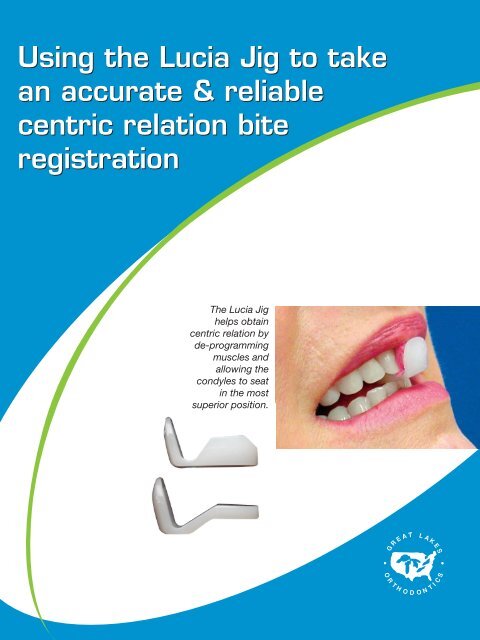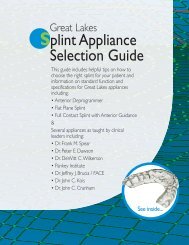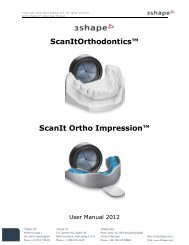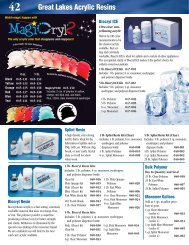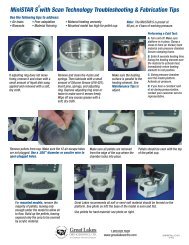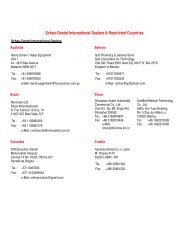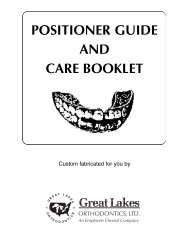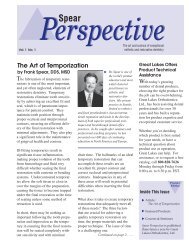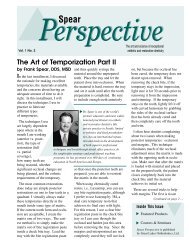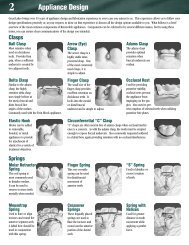Using the Lucia Jig for Bite Registration - Great Lakes Orthodontics
Using the Lucia Jig for Bite Registration - Great Lakes Orthodontics
Using the Lucia Jig for Bite Registration - Great Lakes Orthodontics
You also want an ePaper? Increase the reach of your titles
YUMPU automatically turns print PDFs into web optimized ePapers that Google loves.
<strong>Using</strong> <strong>the</strong> <strong>Lucia</strong> <strong>Jig</strong> to take<br />
an accurate & reliable<br />
centric relation bite<br />
registration<br />
The <strong>Lucia</strong> <strong>Jig</strong><br />
helps obtain<br />
centric relation by<br />
de-programming<br />
muscles and<br />
allowing <strong>the</strong><br />
condyles to seat<br />
in <strong>the</strong> most<br />
superior position.
<strong>Using</strong> <strong>the</strong> <strong>Lucia</strong> <strong>Jig</strong> to take an accu<br />
The method described<br />
in this instructional<br />
guide features <strong>the</strong> <strong>Lucia</strong> <strong>Jig</strong>.<br />
Used by many dental clinicians,<br />
<strong>the</strong> <strong>Lucia</strong> <strong>Jig</strong> is simple, reliable,<br />
reproducible, and com<strong>for</strong>table <strong>for</strong><br />
patients. Frank Spear, DDS, MSD, uses<br />
this technique in his clinical practice and<br />
teaches it in his courses. The technique<br />
is also described in Dr. Spear’s Centric<br />
Relation <strong>Bite</strong> Record DVD. An accurate<br />
bite registration is critical <strong>for</strong> <strong>the</strong> Laboratory<br />
to correctly fabricate an appliance requiring<br />
occlusal coverage. It will reduce initial trimming<br />
and fi tting adjustments and save considerable<br />
chair-time when seating <strong>the</strong> appliance.<br />
The <strong>Lucia</strong> <strong>Jig</strong> helps obtain centric relation by<br />
de-programming muscles and allowing <strong>the</strong><br />
condyles to seat in <strong>the</strong> most superior position.<br />
“It separates <strong>the</strong> posterior teeth, and by<br />
separating <strong>the</strong> posterior teeth it allows <strong>the</strong><br />
lateral pterygoid to release, and when <strong>the</strong><br />
lateral pterygoid releases, <strong>the</strong> condyle<br />
seats…it’s that simple,” explains<br />
Dr. Spear.<br />
For this procedure, ACU-fl ow is used.<br />
It is a syringeable poly vinyl siloxane material<br />
with a 15 second working time, 45 second<br />
intra-oral setting time, and a maximum<br />
total cure time of 1 minute. Once set, it is<br />
extremely hard without being brittle, trims<br />
like acrylic, and remains dimensionally stable<br />
making it ideal to send to <strong>the</strong> Lab.<br />
Selecting <strong>the</strong> right <strong>Lucia</strong> <strong>Jig</strong> is based on<br />
<strong>the</strong> vertical opening of <strong>the</strong> posterior teeth.<br />
Use <strong>the</strong> standard (Class I) jig to determine<br />
<strong>the</strong> vertical opening. If <strong>the</strong>re are several<br />
millimeters (more than 2.5 mm) between<br />
<strong>the</strong> posterior teeth, use <strong>the</strong> Class II jig to<br />
reduce <strong>the</strong> vertical opening.<br />
For patients with very irregular mandibular<br />
incisors, use <strong>the</strong> <strong>Lucia</strong> <strong>Jig</strong> on <strong>the</strong> lower<br />
incisors. It will function in <strong>the</strong> same way<br />
against <strong>the</strong> maxillary incisors.<br />
Standard<br />
Class II
ate & reliable centric relation bite re<br />
Step 1: Paint <strong>the</strong> curved surface of <strong>the</strong> jig with a small<br />
amount of silicone tray adhesive.<br />
Step 2: Dispense Acu-fl ow material into <strong>the</strong> curved<br />
portion of <strong>the</strong> jig.<br />
Step 3: Place <strong>the</strong> jig on <strong>the</strong> upper centrals and place<br />
<strong>the</strong> Whale Tail directly beneath <strong>the</strong> jig. Ask <strong>the</strong> patient<br />
to bite down and hold. The Whale Tail levels and orients<br />
<strong>the</strong> jig to <strong>the</strong> occlusal plane. It parallels <strong>the</strong> jig with <strong>the</strong><br />
occlusal plane anteriorly and posteriorly and in a right<br />
and left direction as well. Allow to set – approximately<br />
45 seconds.<br />
Step 4: Once hard, remove <strong>the</strong> jig and <strong>the</strong> Whale<br />
Tail and trim off <strong>the</strong> excess material with a lab knife.<br />
Remove any material extending over <strong>the</strong> edges of<br />
<strong>the</strong> jig.<br />
Place it back on <strong>the</strong> patient’s upper centrals. Ask <strong>the</strong><br />
patient to bite down onto <strong>the</strong> jig, slide <strong>for</strong>ward, slide<br />
back, and squeeze. Repeat. Ask <strong>the</strong> patient if he or<br />
she feels any tenderness or tension. If <strong>the</strong> answer is<br />
no, <strong>the</strong> pterygoid is relaxed and <strong>the</strong> joint can support<br />
load com<strong>for</strong>tably.<br />
If <strong>the</strong> answer is yes, <strong>the</strong> patient may require an<br />
additional period of time (possibly up to 20 minutes)<br />
to allow <strong>the</strong> pterygoid to relax and <strong>the</strong> condyles to seat.<br />
If after that period of time, <strong>the</strong> discom<strong>for</strong>t persists, a<br />
joint problem may be indicated.<br />
Step 5: <strong>Using</strong> red articulating paper, confi rm that <strong>the</strong><br />
lower centrals are contacting <strong>the</strong> jig evenly. Place <strong>the</strong><br />
red articulating paper between <strong>the</strong> jig and <strong>the</strong> lower<br />
centrals. Ask <strong>the</strong> patient to slide <strong>the</strong> lower incisors<br />
<strong>for</strong>ward and back several times marking <strong>the</strong> jig.<br />
Remove <strong>the</strong> jig. If <strong>the</strong> lines are on both edges or on <strong>the</strong><br />
center of <strong>the</strong> jig, proceed to <strong>the</strong> next step. If <strong>the</strong> line<br />
is only on one side of <strong>the</strong> jig, it will need to be beveled<br />
slightly with an acrylic bur. Repeat step 5.<br />
Lines<br />
appear<br />
on both<br />
edges
istration<br />
Step 6: To determine <strong>the</strong> patient’s most retruded<br />
position, place <strong>the</strong> jig back on <strong>the</strong> patient’s centrals.<br />
Ask <strong>the</strong> patient to bite down, slide <strong>for</strong>ward, back, and<br />
squeeze. Repeat and hold. Ask <strong>the</strong> patient to open<br />
slightly, place black articulating paper between <strong>the</strong><br />
jig and <strong>the</strong> lower centrals and ask <strong>the</strong> patient to tap<br />
three times.<br />
The most retruded point of contact of <strong>the</strong> lower<br />
incisors has now been marked in black on <strong>the</strong> jig.<br />
When <strong>the</strong> bite record is taken, if <strong>the</strong> patient’s lower<br />
centrals are touching those marks, you can be<br />
confi dent that <strong>the</strong> patient is in centric relation.<br />
Step 7: Dry <strong>the</strong> teeth well with dental gauze, this<br />
prevents <strong>the</strong> bite registration material from sliding<br />
down <strong>the</strong> patient’s throat. With <strong>the</strong> <strong>Lucia</strong> <strong>Jig</strong> in<br />
place, ask <strong>the</strong> patient to open and inject an ample<br />
amount of <strong>the</strong> registration material starting on <strong>the</strong><br />
second molars and work up to at least <strong>the</strong> cuspids<br />
on both sides.<br />
Ask <strong>the</strong> patient to slowly close onto <strong>the</strong> marks and<br />
squeeze. The patient must squeeze fi rmly to seat<br />
<strong>the</strong> condyle by using <strong>the</strong> masseter, temporalis,<br />
and medial pterygoid muscles. If <strong>the</strong> patient’s<br />
lower incisors are on <strong>the</strong> most posterior marks<br />
on <strong>the</strong> jig, you know <strong>the</strong> patient has closed into<br />
<strong>the</strong> correct position.<br />
Step 8: Once <strong>the</strong> registration material is hard, ask<br />
<strong>the</strong> patient to open and remove <strong>the</strong> <strong>Lucia</strong> <strong>Jig</strong> and bite<br />
registration material. The bite records should have<br />
very good palatal cusp and buccal cusp recordings<br />
of <strong>the</strong> maxillary teeth and buccal cusp recordings<br />
of <strong>the</strong> mandibular teeth. The bite records are ready<br />
<strong>for</strong> trimming.<br />
Patient’s<br />
most<br />
retruded<br />
position
Trimming Instructions<br />
Trimming <strong>the</strong> silicone bite records is an important<br />
step to ensure an accurate fi t on <strong>the</strong> model.<br />
Trimming eliminates all <strong>the</strong> interferences so<br />
<strong>the</strong>re is no movement once <strong>the</strong> models are<br />
seated into <strong>the</strong> bite record.<br />
Step 1: With a lab knife or diamond disc,<br />
trim any material that extends distal to <strong>the</strong><br />
second molar.<br />
Step 2: With a 1.5 inch fi ne sandpaper<br />
arbor, shorten <strong>the</strong> fl anges of <strong>the</strong> records to<br />
approximately 1.5 mm cusp depth.<br />
Step 3: With <strong>the</strong> round end of an acrylic bur,<br />
remove <strong>the</strong> marginal ridge detail and <strong>the</strong> depths<br />
of <strong>the</strong> fossa. There should only be <strong>the</strong> cusp tips<br />
left, no anatomy or marginal ridges.<br />
When <strong>the</strong> silicone is properly trimmed, <strong>the</strong> bite<br />
will seat perfectly and <strong>the</strong>re will be no rocking<br />
or movement of <strong>the</strong> model.
Products featured<br />
in this guide<br />
<strong>Lucia</strong> <strong>Jig</strong> Kit 255-025<br />
(18 standard and 6 Class II)<br />
Whale Tails 3/pkg. 255-027<br />
Black/Red Double-Sided<br />
Articulating Paper 056-003<br />
Disposable Articulating<br />
Forceps 100/pkg. 056-028<br />
ACU-fl ow <strong>Bite</strong> <strong>Registration</strong><br />
Material 100-005<br />
ACU-fl ow Dispensing Gun 100-010<br />
(not shown)<br />
Carbide Cross-Cut Bur 085-034<br />
1½ in. Fine Sandpaper 060-020<br />
Arbor with Mandrel (10 Arbors/pkg.)<br />
<strong>Lucia</strong> <strong>Jig</strong> <strong>Bite</strong> <strong>Registration</strong> Kit 255-031<br />
Kit includes: <strong>Lucia</strong> <strong>Jig</strong>s, Whale Tails,<br />
Double-sided Articulating Paper,<br />
ACU-fl ow material, Carbide Cross-<br />
Cut Bur, & Sandpaper Arbor with Mandrel<br />
Centric Relation <strong>Bite</strong> Record 270-022<br />
DVD – Dr. Frank Spear (not shown)<br />
Contact <strong>Great</strong> <strong>Lakes</strong> Products Customer Service<br />
<strong>for</strong> more in<strong>for</strong>mation on any of <strong>the</strong>se products, to<br />
request a catalog, or to place an order.<br />
SMPP214Rev111308<br />
S-220<br />
255-025<br />
056-003<br />
100-005<br />
255-031<br />
060-020<br />
255-027<br />
200 Cooper Avenue Tonawanda, New York 14150<br />
E-mail: info@greatlakesortho.com www.greatlakesortho.com<br />
1.800.828.7626 (US & Canada) 716.871.1161 (worldwide) Fax: 716.871.0550<br />
056-028<br />
085-034


